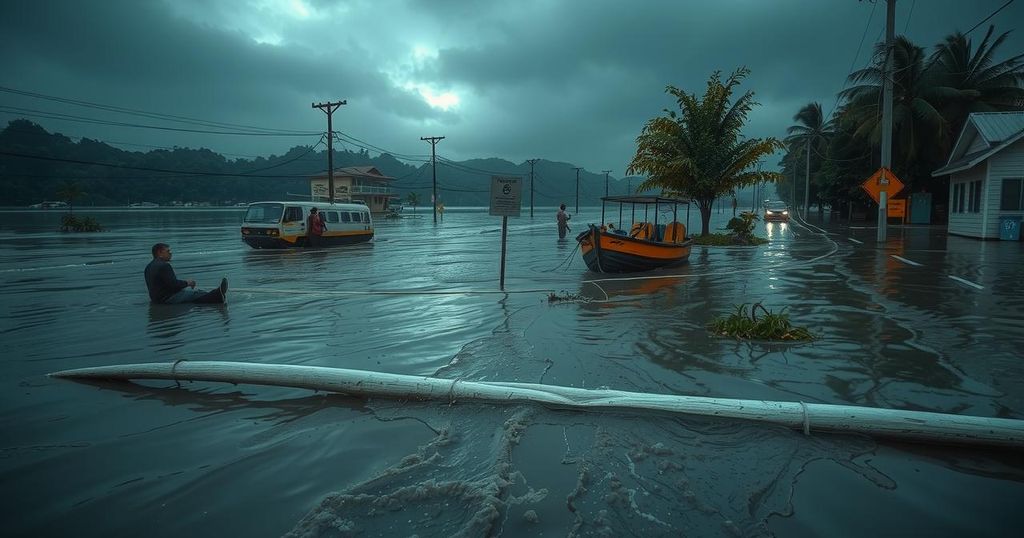Devastating Impact of Tropical Cyclone Kristine in the Philippines

Tropical cyclone Kristine has caused substantial flooding in northern Philippines, resulting in over a dozen deaths and affecting more than a million residents. The storm, identified as Tropical Storm Trami, made landfall after heavy rainfall had already left the region vulnerable to flash floods. Significant rescue efforts are underway, with many individuals stranded at home.
Tropical cyclone Kristine has brought catastrophic flooding to the northern regions of the Philippines, resulting in the deaths of over a dozen individuals and leaving several others unaccounted for. The National Disaster Risk Reduction and Management Council reported that this natural disaster has affected more than one million residents and has likely displaced thousands due to associated landslides and relentless rainfall. Originally termed Tropical Storm Trami by the Joint Typhoon Warning Center, the system formed to the west of Guam and made landfall in the Philippines on Wednesday. The intensity of the storm was exacerbated by heavy rainfall that predated Kristine, as well as prior cyclonic activity earlier in the month, rendering the area particularly susceptible to flash flooding. Distressing images and videos from the worst-affected regions demonstrate residents navigating water levels that reached their chests, while personnel from the Coast Guard facilitated evacuations using boats. Former Vice President Maria Leonor Robredo conveyed the urgency of the situation through social media by noting, “People have been stuck on the roofs of their houses for several hours now. Many of our rescue trucks have stalled due to the floods.” The Philippine Atmospheric, Geophysical, and Astronomical Services Administration predicted daily rainfall exceeding five inches in certain areas that were under the persistent influence of the storm’s bands. Although the capital city of Manila, with a metropolitan population nearing 14 million, is positioned on the southern fringe of the storm’s moisture, officials anticipated significant rainfall as Kristine progressed from east to west across the archipelago. Government assurances indicate that the remnants of Kristine will continue on a northwesterly path away from the islands; however, the likelihood of ongoing rainfall remains as the region is currently in a rainy season. Manila usually experiences approximately 100 inches of rainfall annually, with a discernible dry season during winter and spring months. At present, government agencies have not released comprehensive damage assessments; however, preliminary evaluations suggest that the consequences of the storm will be considerable, with widespread flooding affecting hundreds of communities. Despite a busy cyclone season, the activity noted thus far remains below normal, as at least 10 cyclones have impacted the islands this year, with more than two months remaining in the season. Experts attribute this variance partially to a neutral state described as a ‘La Nada’ event occurring across the Pacific, influencing global weather patterns.
Tropical cyclones are severe weather systems characterized by rotating winds that form over warm ocean waters. The Philippines is highly prone to typhoons, being located in a region where such systems frequently develop. The country’s geographic position, coupled with its vulnerability to climatic variations due to phenomena like El Niño and La Niña, exacerbates the impact of these storms. Heavy rainfall due to cyclonic activity often leads to landslides and flooding, significantly affecting local communities and infrastructure. Historical data show that typhoons cause substantial loss of life and property in the Philippines, underscoring the necessity for effective disaster risk management and response mechanisms.
In summary, the recent tropical cyclone Kristine has resulted in tragic consequences across northern Philippines, marked by loss of life, widespread flooding, and significant disruption to community safety and infrastructure. With a million residents affected and many displaced, the situation remains critical as the nation assesses damage amidst ongoing rainfall. As the Philippines continues to grapple with natural disasters exacerbated by climatic changes, enhanced preparedness and resilient strategies become essential.
Original Source: www.foxweather.com






